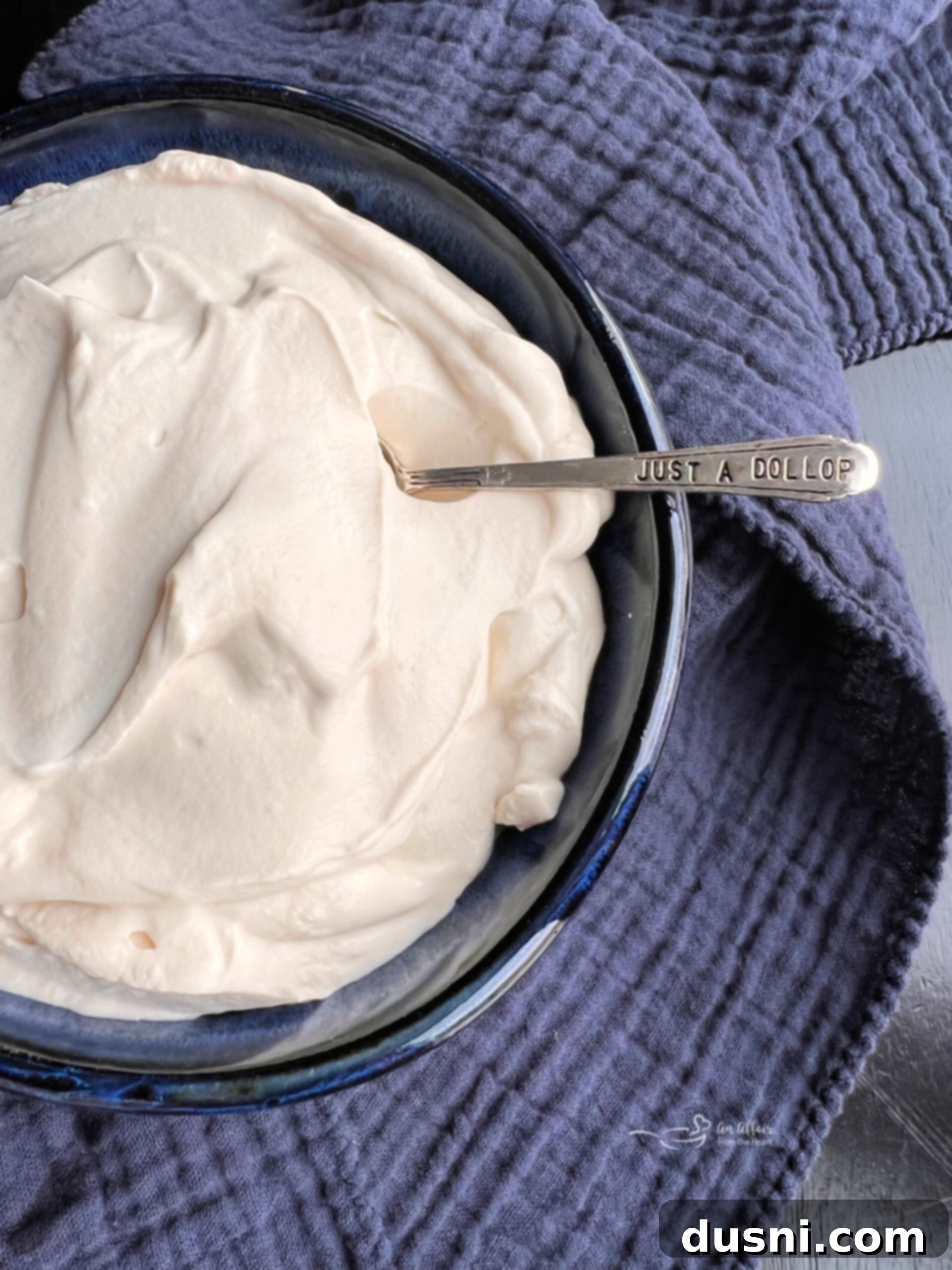Homemade Devonshire Cream: Your Essential Guide to Rich, Velvety Clotted Cream for Scones & Desserts
Devonshire Cream, often referred to as clotted cream or Cornish cream, is a luxurious, thick, and velvety topping traditionally enjoyed throughout England, particularly as an accompaniment to freshly baked scones during afternoon tea. While its authentic preparation involves a slow-baking process of heavy cream to form those distinctive “clots,” this exquisite homemade version captures the same rich flavor and luxurious texture with remarkable ease and speed. You’ll be amazed at how simple it is to whip up this decadent cream right in your own kitchen, wondering why you hadn’t tried it sooner. It’s the perfect way to elevate any dessert into a truly special occasion.

For those of us living in the United States, the concept of Devonshire Cream might not be a familiar one. My own introduction to this delightful treat came through a gracious friend, Andi, who hosted the most charming and elaborate afternoon tea parties for our sons’ preschool class. Her spreads were legendary, and it was at one of these gatherings that I first tasted Devonshire Cream. She served it alongside her magnificent Chocolate Bliss Cake, and it was an absolute revelation. Unlike the often overly sweet ice cream or sweetened whipped cream commonly used as dessert toppings, Devonshire Cream offers a subtly sweet, slightly tangy profile that perfectly complements rich desserts. Its balanced flavor enhances without overwhelming, making it an ideal partner for chocolate, fruit tarts, and, of course, the quintessential English scone. It truly adds a touch of sophistication and an authentic English flair to any sweet treat.
Mastering Homemade Devonshire Cream: A Taste of English Elegance
This incredible, easy-to-follow recipe for Devonshire Cream is a treasured gift from Andi, the very same hostess who opened my eyes to the wonders of this English delicacy. Thanks to her generosity, we can now effortlessly bring a slice of authentic English tea party charm right into our homes. This simple homemade clotted cream recipe is not only quick to prepare but also requires just a handful of everyday ingredients, proving that gourmet flavors don’t have to be complicated. Once you experience its creamy, rich texture and balanced sweetness atop your favorite desserts, you’ll undoubtedly want to ensure a constant supply in your refrigerator. Its versatility and irresistible taste make it a staple you’ll find yourself reaching for again and again, transforming ordinary moments into extraordinary ones.
What makes this dessert topping truly remarkable is its simplicity. Crafted from just three core ingredients – heavy whipping cream, a generous dollop of sour cream, and a touch of powdered sugar and vanilla – it comes together with surprising ease. The combination creates a thick, luxurious cream that is remarkably stable. Once prepared, this delightful cream will keep beautifully for 3-4 days when stored in an airtight container in the refrigerator, allowing you to enjoy its fresh taste over multiple days. However, for the best texture and flavor, I generally advise against freezing it, as it can alter the delicate consistency. Its convenient shelf life means you can prepare it ahead of time, ensuring you’re always ready to elevate an impromptu tea time or a planned dessert course.
You’ll quickly discover that Devonshire Cream isn’t just for scones; its subtle sweetness and incredible richness make it the ultimate versatile topping. From fresh berries to decadent chocolate cakes, fruit pies, and even simple puddings, this velvety cream has a magical way of enhancing every bite. Our family has completely embraced it, and now, it’s a regular practice to pull out a container of this delightful clotted cream from the fridge to adorn nearly all our desserts. It’s a game-changer that transforms everyday sweets into something truly special and memorable. Speaking of other fantastic dessert enhancements, you’ll definitely want to explore this luscious Honey Bourbon Sauce and my vibrant Homemade Raspberry Sauce while you’re here today – they’re perfect companions for a variety of treats!

Essential Ingredients for Authentic Taste and Texture
Achieving the perfect homemade Devonshire Cream requires a few key ingredients, each playing a crucial role in developing its signature rich flavor and delightfully thick texture. While the recipe is simple, the quality and type of ingredients make all the difference. For precise measurements and step-by-step instructions, please scroll down to the printable recipe card located at the bottom of this post.
- Heavy whipping cream – This is the foundation of our cream. I specifically use 8 ounces of heavy whipping cream. It is absolutely essential to stick with heavy cream for this recipe, as its high-fat content (typically 36% or more) is what allows it to whip into firm, stable peaks and contribute to the rich mouthfeel we’re aiming for. Do not be tempted to substitute with lower-fat options like light cream or half-and-half, as they simply won’t yield the desired luxurious texture or structure.
- Sour cream – The addition of sour cream is the secret ingredient that imparts that characteristic slight tang and contributes significantly to the unique, thick consistency of Devonshire cream. I always opt for full-fat sour cream. Just like with the whipping cream, using a low-fat or fat-free sour cream alternative will compromise both the taste and the luxurious texture, resulting in a thinner, less satisfying product. The full-fat version ensures maximum richness and flavor.
- Powdered Sugar – Also known as confectioners’ sugar, this finely milled sugar is perfect for sweetening the cream. I typically add a few tablespoons of powdered sugar, adjusting to taste, to give the cream a subtle sweetness that balances the tang of the sour cream without making it overly cloying. Powdered sugar dissolves seamlessly into the cream, ensuring a smooth finish without any granular texture, unlike granulated sugar.
- Vanilla – A touch of vanilla extract elevates the overall flavor profile, adding warmth and depth. I strongly recommend using pure vanilla extract. The nuanced, aromatic notes of real vanilla are far superior to imitation vanilla, which can sometimes have an artificial aftertaste. If possible, invest in a good quality pure vanilla extract for the best results; it truly makes a difference in the final taste of your homemade Devonshire Cream.
Crafting Your Perfect Devonshire Cream: A Simple Method
Making this delightful Devonshire Cream is surprisingly straightforward, transforming a few simple ingredients into a luxurious topping in just minutes. The key is in the technique, ensuring each component is incorporated correctly to achieve that signature thick and velvety texture.

First: Begin by combining your heavy whipping cream, powdered sugar, and vanilla extract in a chilled mixing bowl. Using a stand mixer with the whisk attachment or an electric hand mixer, whip the mixture on medium-high speed. Continue beating until the cream transforms into firm, stiff peaks. This means that when you lift the whisk, the cream will hold its shape without drooping. Be careful not to over-whip, as this can turn your cream grainy. Watch it closely; it usually takes only a few minutes to reach the perfect consistency.
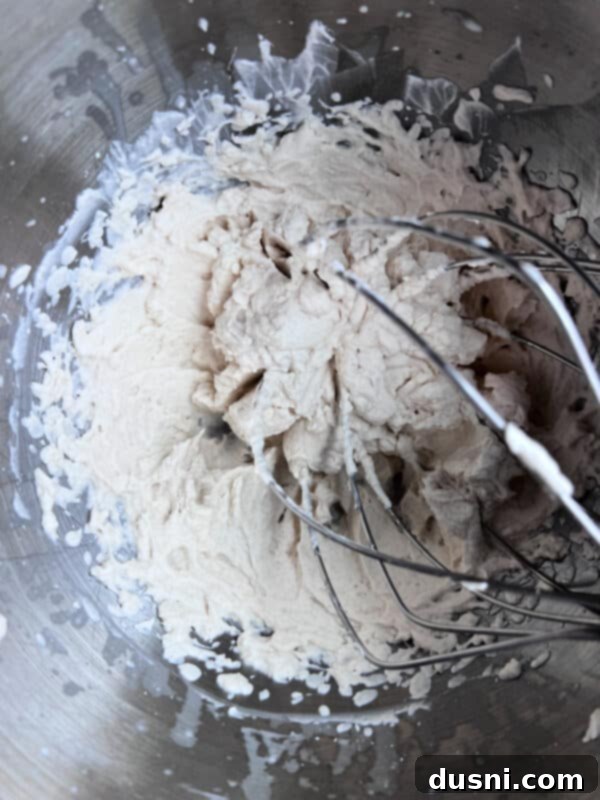
Second: Once your whipping cream mixture has reached stiff peaks, it’s time to gently incorporate the sour cream. Using a spatula, carefully fold the full-fat sour cream into the whipped cream. The goal here is to combine them thoroughly without deflating the air you’ve whipped into the cream. Fold until the mixture is homogenous and beautifully smooth, ensuring no streaks of sour cream remain. This gentle folding technique helps maintain the light, airy texture while integrating the tangy richness of the sour cream.

Third: After mixing, transfer your homemade Devonshire Cream to an airtight container. It is crucial to keep the cream well-chilled in the refrigerator until you are ready to serve. This not only preserves its fresh taste but also maintains its ideal thick consistency. Allowing it to chill for at least 30 minutes before serving can also help the flavors meld beautifully, making it even more delectable. Serve it cold to enjoy its refreshing creaminess to the fullest.

Loved This Recipe? Pin It for Later!
If you’ve fallen in love with this easy and delicious homemade Devonshire Cream recipe, don’t let it slip away! Make sure to save it for future enjoyment by pinning it to your favorite Pinterest recipe board. This way, you’ll always have this fantastic recipe at your fingertips for your next tea party or dessert craving!
Frequently Asked Questions About Devonshire Cream
Delving into the world of traditional English creams can sometimes bring up a few questions. Here, we address some of the most common inquiries about Devonshire Cream and its delicious relatives.
What is clotted cream? Clotted cream is a remarkably thick, rich cream that gains its unique texture from a traditional preparation method where full-fat milk (typically Jersey or Guernsey cow’s milk) is slowly heated and then left to cool. During this cooling process, the cream separates and forms “clots” or a thick crust on the surface. It is a dairy product with a centuries-old history, believed to have originated in the southwest of England, particularly in Devon and Cornwall. Clotted cream is most famously and traditionally served with scones, often alongside jam, as part of a quintessential English cream tea.
How is traditional clotted cream made, and how does this recipe differ? Traditional clotted cream is indeed made by slowly heating full-fat dairy milk, usually from Jersey cows known for their high milk-fat content, over a water bath or steam for several hours. The cream is then allowed to cool undisturbed in the pan, during which time the distinctive clots rise to the surface. This recipe, however, offers a *mock* or *quick* Devonshire Cream. It achieves a remarkably similar taste and luxurious, thick texture using a whipping method with heavy cream, sour cream, and a touch of sweetness, providing a delicious and much faster alternative to the traditional slow-cook method, without sacrificing much of the authentic experience.
What is Devonshire cream used for? Devonshire cream, just like traditional clotted cream, is primarily used as a luxurious topping for desserts. In the United States, we often use whipped cream or ice cream for a similar purpose, but Devonshire cream offers a more complex, less-sweet flavor profile. Its most iconic use is undoubtedly alongside scones as part of an English cream tea, where it’s typically dolloped generously. Beyond scones, it’s also excellent with fresh berries, fruit tarts, pies, crumbles, chocolate desserts, and even coffee or hot cocoa, adding an indulgent, creamy richness.
What is the difference between clotted cream and Devonshire cream? While often used interchangeably and referring to essentially the same rich, thick cream, the distinction is geographical. “Clotted cream” is the general term for this type of cream. “Devonshire cream” specifically denotes clotted cream that is made in the county of Devon, England. Similarly, “Cornish cream” refers to clotted cream produced in Cornwall. The slight regional variations in production can sometimes lead to subtle differences in texture or color, but fundamentally, they belong to the same category of delightful, slow-cooked dairy products.
What does Devonshire cream taste like? Devonshire cream offers a truly unique taste experience. It’s similar to traditional heavy cream but boasts a much richer, denser mouthfeel. Its flavor is mildly sweet with a subtle, pleasant tang, largely due to the sour cream in this recipe (or natural fermentation in traditional clotted cream). It’s less sweet than most whipped creams and has a deeper, more buttery note than standard heavy cream, making it incredibly satisfying without being overly sugary. It’s a sophisticated flavor that complements a wide range of desserts beautifully.
Can I freeze homemade Devonshire Cream? While you can technically freeze whipped cream, it’s generally not recommended for this homemade Devonshire Cream. Freezing and thawing can alter the delicate emulsion and texture of the cream, often making it grainy or separating the fats, resulting in a less desirable consistency. For the best experience, it’s best to enjoy this cream fresh within its recommended refrigerated shelf life of 3-4 days.
What is the difference between Devonshire cream and double cream? It’s true, the world of cream can be quite confusing with so many delicious variations! While Devonshire cream and clotted cream are essentially the same (with regional naming differences), double cream is quite distinct. Double cream is a type of rich, high-fat cream popular in the UK, similar to what we in the US might call very heavy whipping cream. It typically has a fat content of 48% or more, making it much thicker and more decadent than standard whipping cream. Unlike Devonshire cream, which has a unique clotted texture and subtle tang, double cream is simply a very rich liquid cream that can be whipped or used as is. Double cream is often sweetened for desserts, whereas Devonshire cream has a more inherent, balanced sweetness and tang from its unique preparation.
Clever Substitutions for Your Homemade Cream
When I was perfecting this recipe, I was quite surprised by the sheer number of delicious variations and interpretations of Devonshire cream and clotted cream I encountered. While this recipe provides a fantastic and authentic-tasting result, it’s good to know there are some thoughtful substitutions you can explore if you’re looking for a slightly different flavor profile or need to work with what you have on hand. These alternatives can yield a cream that is similar in richness and texture, though perhaps with a nuanced difference in taste.
- Mascarpone or full-fat cream cheese can be substituted for whipping cream. If you’re out of heavy whipping cream, mascarpone cheese or softened full-fat cream cheese can be excellent alternatives. When whipped, mascarpone provides an incredibly rich, luxurious texture and a slightly sweet, mild flavor that is very complementary. Full-fat cream cheese, when softened and whipped, can also create a wonderfully thick and tangy cream, though it will have a more pronounced “cream cheese” flavor. Adjust sugar levels to taste, as these options tend to be less sweet than whipped cream.
- Full-fat yogurt or Greek yogurt can be used instead of sour cream. For a slightly different tang and body, full-fat plain yogurt or, even better, full-fat Greek yogurt can stand in for sour cream. Greek yogurt, with its thicker consistency and higher protein content, will contribute a similar creamy texture and a bright, tangy note to the mixture. Ensure you use *full-fat* versions for the best richness and to prevent the cream from becoming too thin. The flavor will be a bit tangier and lighter than with sour cream, offering a fresh twist.
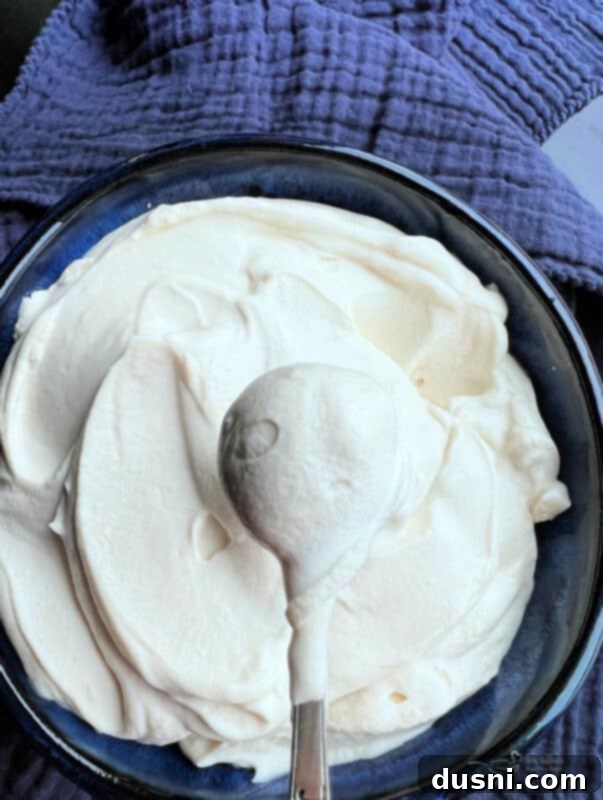
Expert Tips & Tricks for Perfect Devonshire Cream
Achieving perfectly thick, stable, and delicious Devonshire Cream is easy when you keep a few professional tips in mind. These simple techniques will ensure your homemade cream turns out beautifully every time:
- Chill Your Equipment: To significantly facilitate the whipping of the cream, place the mixing bowl (preferably a metal one) and your whisk attachment (or beater blades) in the fridge or freezer for at least 15-30 minutes, or even a few hours, before you start preparing the cream. Cold equipment helps the fat globules in the heavy cream stiffen faster and hold their shape better, resulting in a firmer, more stable whipped cream.
- Start with Cold Ingredients: Always make sure your heavy whipping cream is straight from the fridge and very cold. Cold cream whips up more efficiently and produces a more voluminous and stable result. If your cream is lukewarm, it will take much longer to whip and might not reach the desired stiff peaks. The sour cream should also be cold for optimal blending.
- Don’t Over-Whip: While you’re aiming for stiff peaks with the heavy cream, be mindful not to over-whip it. Over-whipped cream can quickly turn grainy or even start to separate into butter and buttermilk. Stop whipping as soon as the cream holds its shape firmly.
- Gentle Folding is Key: When incorporating the sour cream into the whipped cream, use a gentle folding motion with a spatula. This ensures that you don’t deflate the air you’ve carefully whipped into the cream, preserving its light and airy texture.
- Adjust Sweetness to Taste: The recommended amount of powdered sugar provides a subtly sweet cream that balances the tang of the sour cream. However, feel free to adjust the amount to your personal preference. Add a little at a time and taste as you go to achieve your perfect level of sweetness.
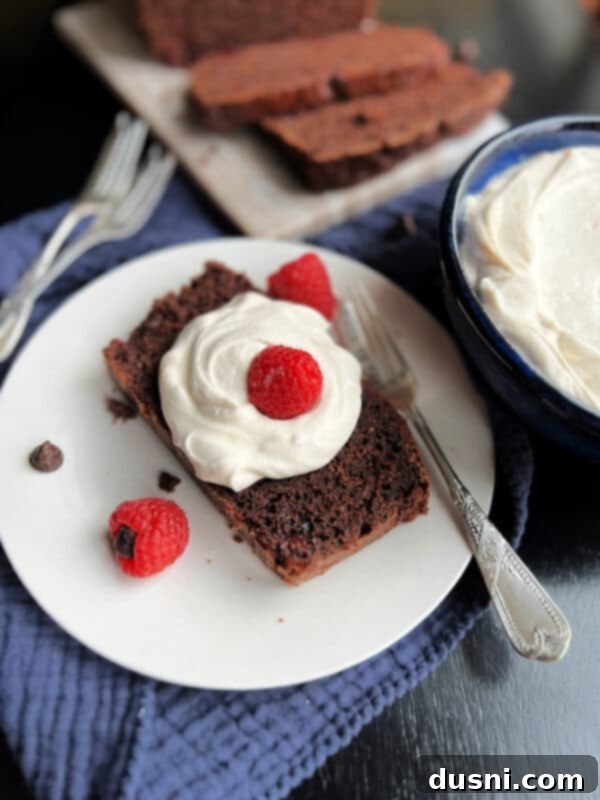
Delightful Ways to Serve Your Homemade Devonshire Cream
Once you’ve crafted your batch of rich, velvety Devonshire Cream, the possibilities for enjoyment are endless! While it’s the undisputed star of an English tea, its versatile flavor and texture make it a magnificent accompaniment to a wide array of desserts and sweet treats. Here are some of our favorite ways to serve this luxurious topping:
Classic Scones: This is, without a doubt, the most traditional and cherished pairing. Serve a generous dollop of Devonshire Cream on warm, freshly baked homemade scones. Traditionally, it’s layered with a sweet preserve like strawberry jam or a tangy lemon curd for a truly authentic and special English tea experience.
Fresh Fruit: Elevate a simple bowl of fresh berries (strawberries, raspberries, blueberries, blackberries) or sliced peaches by adding a spoonful of Devonshire Cream. The cream’s subtle sweetness and tang perfectly complement the natural flavors of the fruit, making for a light yet indulgent dessert.
Pies and Tarts: Replace traditional whipped cream or ice cream with Devonshire Cream to add a gourmet touch to your favorite fruit pies, custard tarts, or even a classic apple crumble. Its richness stands up beautifully to the warm, comforting flavors of baked desserts.
Cakes and Puddings: Whether it’s a slice of pound cake, an elegant sponge cake, or a warm bread pudding, Devonshire Cream provides an exquisite counterpoint. Its less-sweet profile means it won’t overwhelm a delicately flavored cake but will add a layer of luxurious creaminess.
Clotted Cream Cookies: For an extra special treat, consider pairing it with a Clotted Cream Cookie. The double dose of rich creaminess is absolutely irresistible!
This thick, rich, and surprisingly simple homemade version of Devonshire Cream is guaranteed to take any dessert from good to absolutely extraordinary. I promise, once you experience its decadent texture and balanced flavor, it will fundamentally change the way you think about and top your favorite treats. So, gather your ingredients, embrace the spirit of English afternoon tea, and give this incredible recipe a try today!

LIKE THIS RECIPE?
Don’t forget to give it a ⭐️⭐️⭐️⭐️⭐️ star rating and
leave a comment below the recipe!
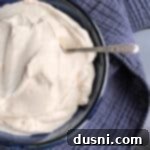
Print Recipe
Devonshire Cream (Homemade Clotted Cream Recipe)
Equipment
-
Kitchenaid Stand Mixer
-
KitchenAid Hand Mixer
Ingredients
- 8 ounces heavy whipping cream
- 1 cup of sour cream
- 3-6 Tablespoons of Powdered Sugar
- 1 teaspoon vanilla
Instructions
-
Whip whipping cream, sugar, and vanilla until stiff peaks form.
-
Fold in the sour cream.
-
Keep cold until ready to serve.
Nutrition
